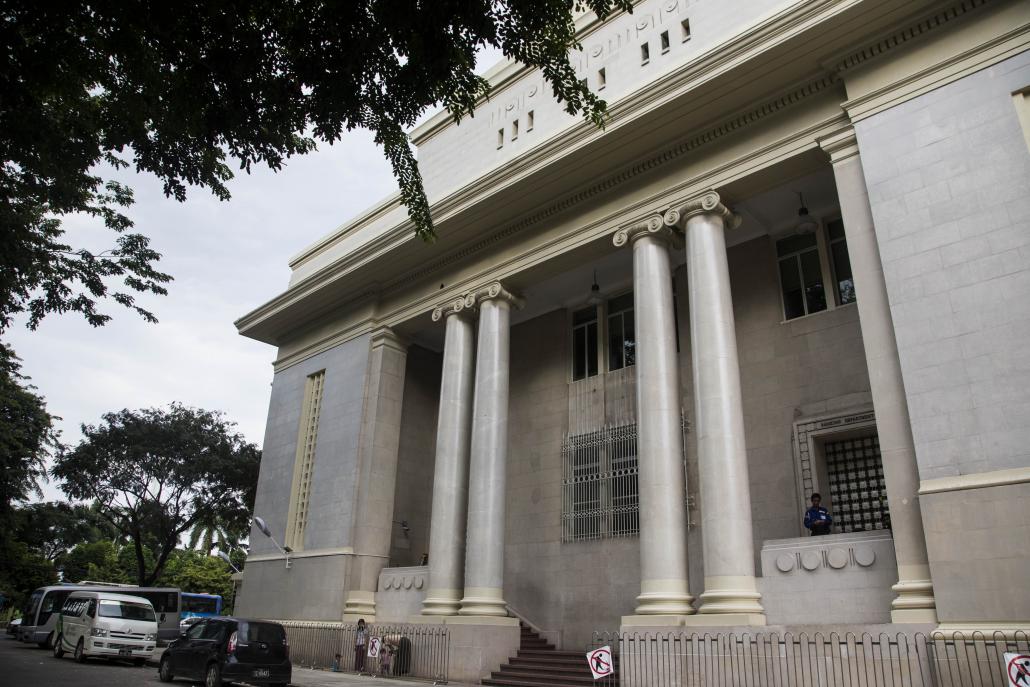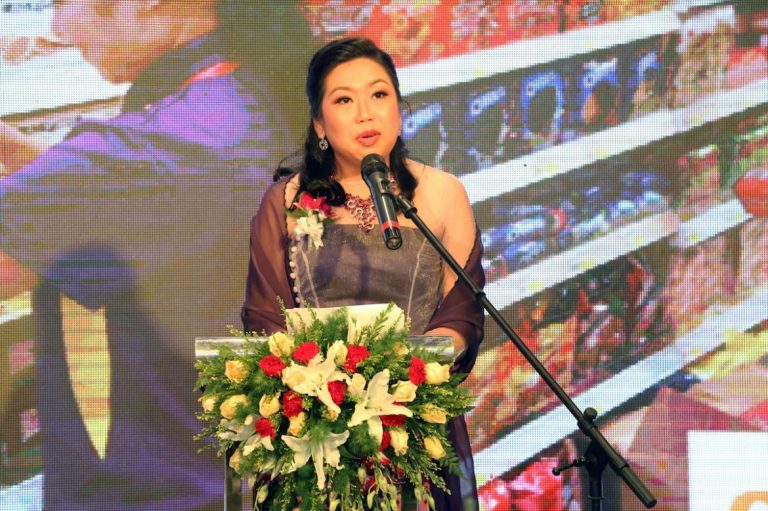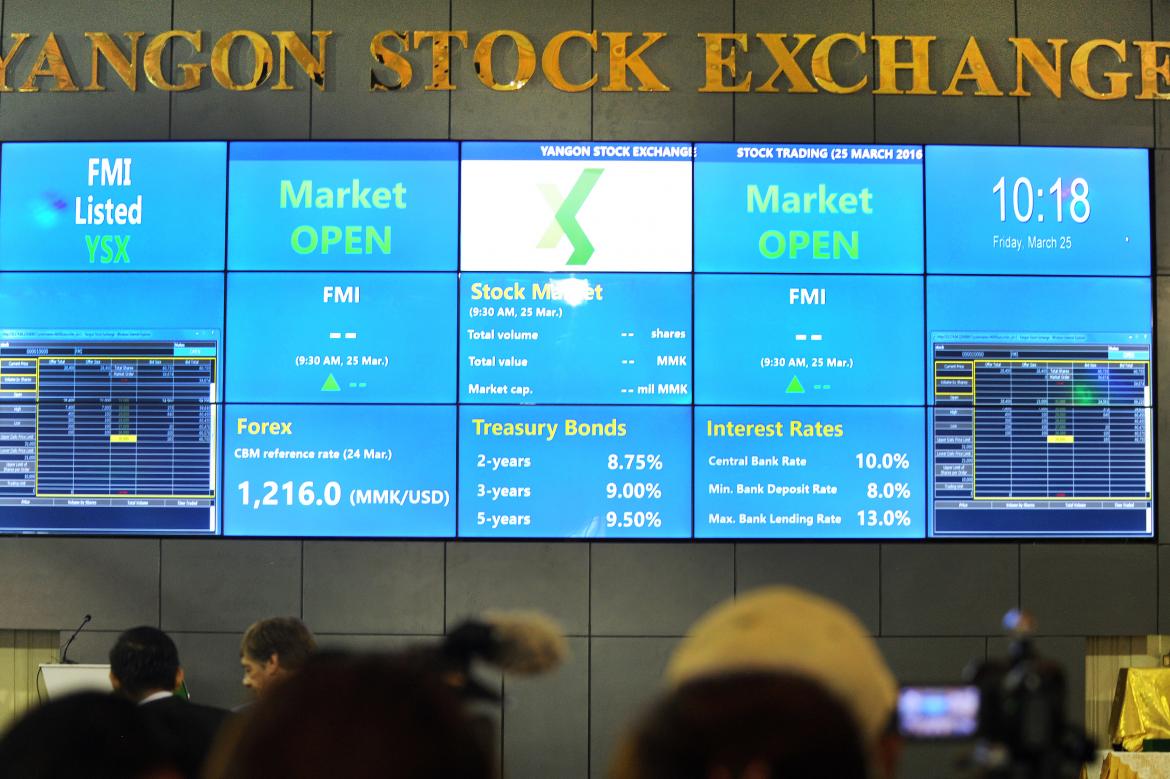The long-awaited Yangon Stock Exchange is due to open in early December and there are a few things you need to know if you’re planning to play the market.
By KYAW PHONE KYAW | FRONTIER

The Yangon Stock Exchange building. (Ann Wang / Frontier)
The classic colonial-era structure on Sule Pagoda Road was built in 1937 and embodies the country’s modern financial history.
It was where British and Japanese rupees were printed and destroyed. Hours before the Japanese captured Yangon in 1942, British soldiers burnt more than 300 million rupees to prevent them from falling into enemy hands. When the Japanese retreated in 1945, they burnt their rupees there for the same reason.
The building served as headquarters of the central bank of Burma during British rule and the Japanese used it as their main financial institution during their occupation of the country in World War II.
Support more independent journalism like this. Sign up to be a Frontier member.
After Myanmar regained independence in 1948, U Nu’s government used the building as the central bank and the mint for the country’s new currency, kyats and pyas. After General Ne Win seized power in 1962 and under successive military regimes, the building served as the headquarters of the military-owned Myawaddy Bank.
Now, all is quiet in this striking example of neo-classical architecture. The doors are shut, but not for long. Soon the building will be reborn as the headquarters of Myanmar’s first stock market, the Yangon Stock Exchange, marking yet another pivotal step for the country’s financial system.
Time Line
Myanmar is one of the few countries in the world without a stock exchange, a distinction it shares with Brunei, Chad, Andorra and North Korea. The former junta tried and failed to establish a stock exchange with support from the Japanese government 19 years ago.
In 2012, President U Thein Sein’s administration renewed efforts to establish a bourse, assigning the task to the deputy finance minister, U Maung Maung Thein, a retired general manager of state-owned Myanma Insurance. U Maung Maung Thein has chaired the Securities and Exchange Commission of Myanmar since it was established in August 2014, a year after the Union parliament passed the Securities and Exchange Law.
A bell will ring in the YSX for the first time during the first week of December to mark the historic start of trading on the bourse. Here’s what you need to know if you’re planning to invest in the share market.
Who owns YSX?
Two Japanese enterprises and the Myanma Economic Bank jointly own the stock exchange. Japan Exchange Group and Daiwa Institute of Research own 49 percent of the local bourse and state-owned MEB owns 51 percent. The intial capital of YSX is K31 billion (about US$24.2 million.)
YSX regulations
Foreign nationals are prohibited under the Securities and Exchange Law from investing in the YSX. Foreign companies are also prohibited from listing on the YSX under the Securities and Exchange Law and the stringent terms of the Companies Act, which specify that a company with as little as one percent foreign ownership is regarded as a foreign company. Foreign joint ventures cannot be listed.
Although share market transactions are not taxed in other regional emerging markets, such as Vietnam and Laos, there is no such concession in Myanmar. The SECM has decided that if you invest in the YSX, you will be liable for commercial tax on your investments.
SECM chairman U Maung Maung Thein has said that “transparency” will be the main criteria for choosing companies to list on the bourse.
If a company wants to be listed, it is required sell 10 percent of its shares to the public, to a minimum of 100 shareholders. The company must have been profitable for the past two consecutive years and have a minimum of K500 million in registered capital. The most important criteria for listing are “good corporate-governance” and “financial stability,” said a SECM statement.
It is not yet known which companies will be chosen for listing but there was an October 23 deadline for submitting expressions of interest and the SECM is expected to name the companies soon.
The minimum capital amounts for service providers are K15 billion for underwriters, K10 billion for dealers, K7 billion for brokerage companies and K30 million for consultancies. Nearly 60 companies have sought service provider roles, with most applying for underwriting licences. The service provider companies will be announced by the SECM.
Kanbawza Bank, which has the country’s biggest branch network, has so far been designated by the SECM as the only financial institution for settling YXS trades, but more banks will be assigned that role in future.
Who are the potential listed companies
Enterprises that meet the definition of a public company have the best potential to be listed because they have sold shares to the public. More than 200 companies are registered with the Directorate of Investment and Company Administration as public companies.
U Maung Maung Thein has indicated that up to five companies will initially be permitted to list.
Serge Pun, who chairs diversified conglomerate First Myanmar Investment, as well as Singapore-listed Yoma Strategic Holdings, has been quoted as saying FMI will be the first company to launch an initial public offering on the YSX.
Other strong candidates for listing, including the Myanmar Agribusiness Public Corporation (MAPCO) and Asia Green Development Bank, seem likely to postpone their IPOs.
Conflict of interest?
Daiwa’s involvement in the YSX has attracted some criticism because of a possible conflict of interest. The drafting of the Securities and Exchange Law was assisted by specialists from the Daiwa Institute of Research which is one of the biggest shareholders in the YSX. Daiwa Securities has already been licensed as the first service provider at the bourse.
Market sources say a significant challenge for the YSX will be recruiting skilled personnel, the shortage of which also contributed to a delay in establishing the SECM.
Service providers will also face human resources challenges, said Ko Aung Thura, the chief executive officer of Thura Swiss, one of the companies that has applied for a licence.
What’s the latest?
Procedural bylaws for the Securities and Exchange Law are due to take effect on October 27, 90 after the legislation was submitted to the Union parliament by the Finance Ministry. The bylaws include detailed regulations on listed companies, IPO procedures and the responsibilities of the SECM.
Ring the bell?
A bell named Aung Zeyatu, which means ‘Achievement’, was installed at the YXS on August 21, in line with bourse tradition for a bell to signal the start and close of trading.
The ringing of the bell on opening day promises to herald a new era for the financial sector in Myanmar, or at least, a new role for a 78-year-old building.







